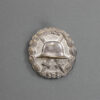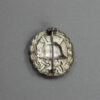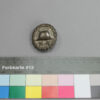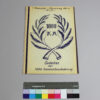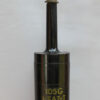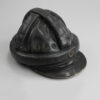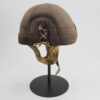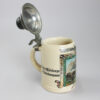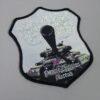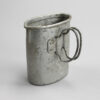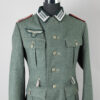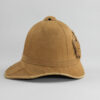Wounded Badge 1st WK in silver
Inventory number: DPM 3.1.16
The First World War not only produced millions of dead, but also various medals and badges to honor its survivors. One special feature is the Wounded Badge, which is not an award for special deeds or participation in a battle or the war in general. Kaiser Wilhelm II donated it on March 3, 1918 in three levels (black, silver, gold) for soldiers who were wounded or maimed in the war. It is quite simply designed with a steel helmet framed by oak leaves in front of crossed swords, a symbol of protection that seems highly inappropriate for the purpose of the foundation. Similar badges were also donated in other countries, for example in Italy and Great Britain.
By the end of 1936, 442,669 veterans had applied for wounded veterans’ badges. Those who had been wounded three to four times were eligible to apply for the second, silver-colored level, regardless of the degree of injury. From the beginning of 1936, the higher levels could also be applied for in the case of particularly serious injuries such as the loss of limbs or eyesight.
The care of the war wounded was initially regulated according to their rank in the war and from 1920 according to the degree of their disability in the Severely Disabled Persons Act. Wearing the wounded badge did not confer any real benefits; like other decorations, it had a symbolic function: it made visible mutilations recognizable as “sacrifices for the war” and also represented an appeal to fellow human beings.
With the global economic crisis and the increasing impoverishment of large sections of the German population, especially war invalids and other recipients of state benefits, the social recognition of invalids rapidly declined. With increasing distance from the war, public opinion shifted to the effect that veterans should make more of an effort to join civil society instead of asking for (state) handouts.
This way of thinking can already be found in the Severely Disabled Persons Act of 1920, according to which mainly curative and reintegration measures into the world of work were promoted. War-disabled people were thus expected to finance themselves again as quickly as possible. Those who did not succeed in doing so or who were denied this, such as those with facial injuries, who found it particularly difficult to find work due to their difficult to conceal mutilation, quickly found themselves on the margins of society. To this day, one of the most famous photos of the 1920s is the begging war veteran with the Iron Cross and wounded badge on the side of the road.
Object of the month
(short) stories from the depot
Unfortunately, many objects cannot currently be shown in the exhibition for conservation reasons. Here you will find unusual objects and exciting stories of special pieces from the depot


